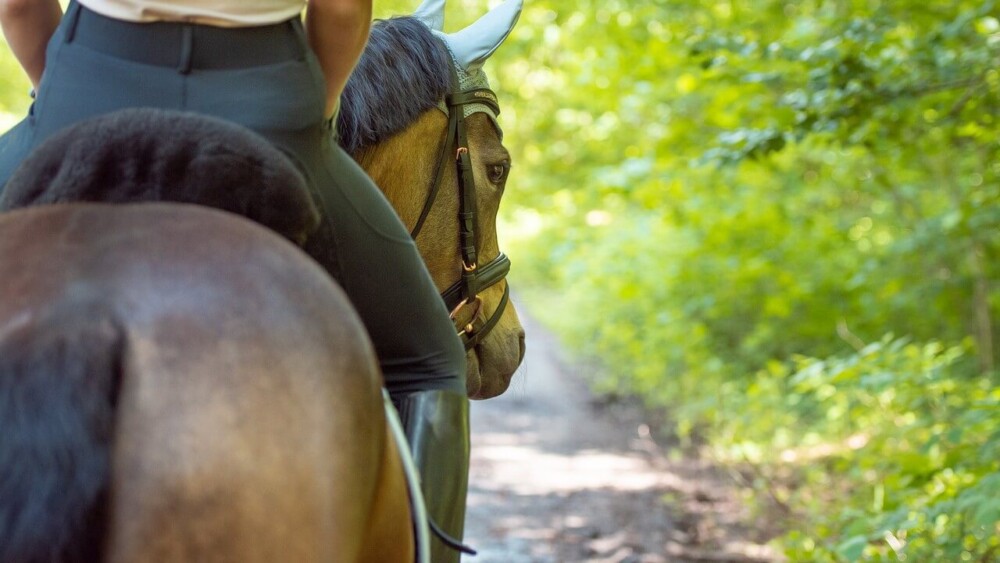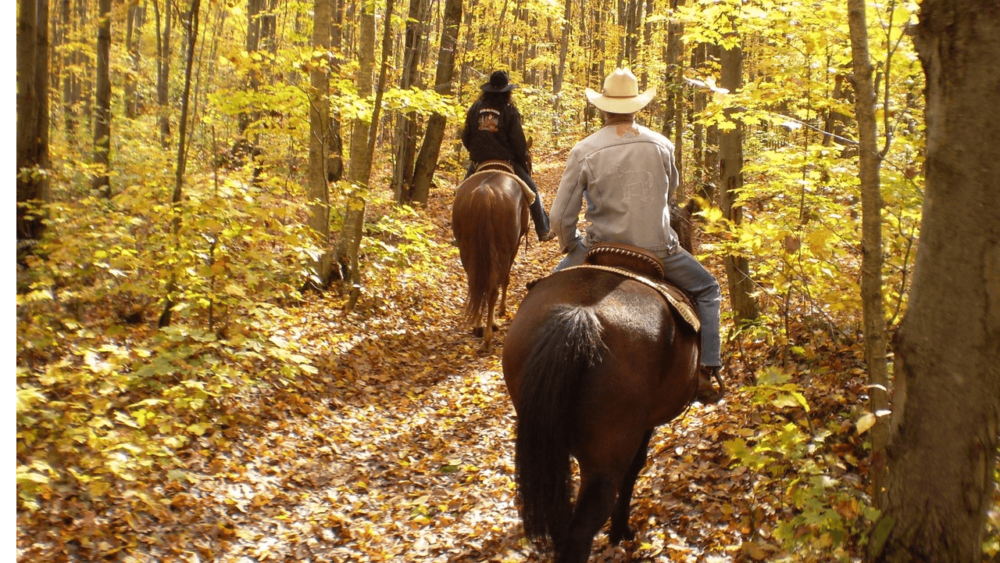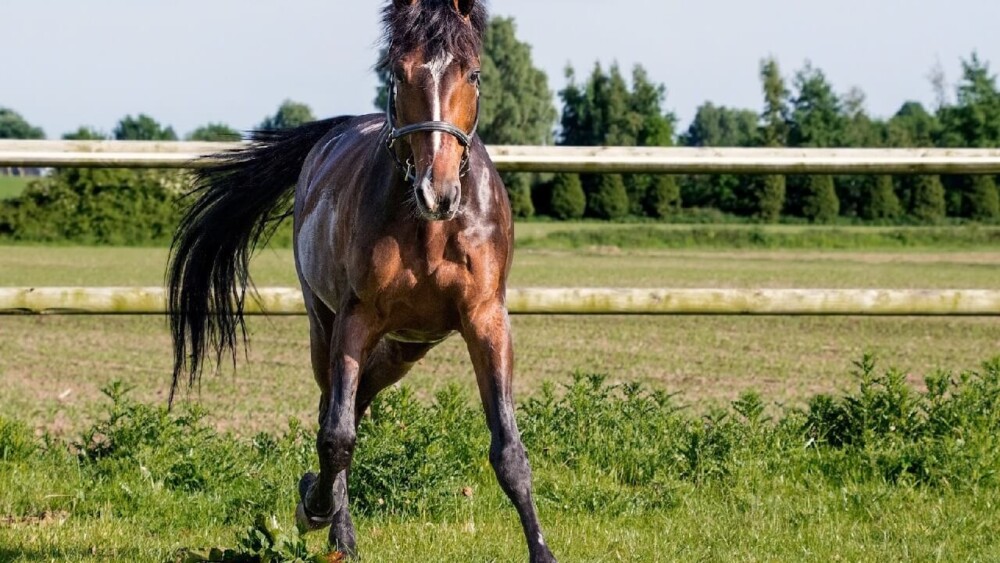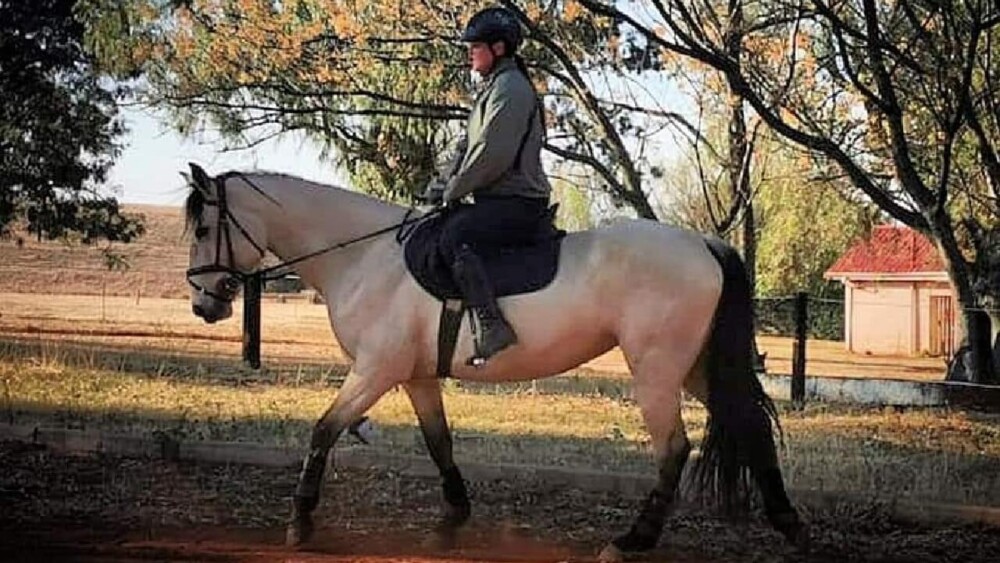You’re happily riding along with your horse, entirely in your element, when disaster strikes. Something stirs among the roadside trees or wiggles in the long grass next to you, and your calm and obedient horse turns into a snorting, fearful dragon.
Just how do you ride a skittish horse safely? With a secure position in the saddle, you will find your horse much more responsive and easier to control. Next, it takes some riding skill to gain control of the forequarter and prevent your lovely horse from spinning and racing away.
My golden rule is: heels down, hands wide and down, head up, and BREATHE. Learn the finer points of skittish horse management right here. Riding a skittish horse is not something most people want to do, but handling your horse’s nervousness is something every rider needs to learn and apply.
Find our common reasons horses become skittish and how to handle horse spook.
With over a decade of horse management experience, I have had the opportunity to help many nervous riders through their horse behavioral issues. I’ve seen it all, from helping them with training to talking them through a challenging incident with a horse that has suddenly gotten a fright. The formula seems to stay the same: put your heels down, keep your hands wide and low, look up, and breathe. Here’s how that looks:
Basic Skittish Horse Riding Recipe (A.K.A. Crisis Management)
Although you may be scared at the moment, it’s essential to stay calm. Your horse will sense your fear and tension.
Keep Your Heels Down
Many people ride with their toes as the lowest part of their foot. It happens when the rider changes their position in the saddle, hunches forward, or tucks their legs up. Not only is this dangerous, but it also changes the way you sit in the saddle. Your voice and hands are not the main way you communicate with your horse. Your seat is the most direct line of communication.
A relaxed seat, with long legs down the sides of your horse, lowered heels, and a reassuring pressure calms a horse quickly. This doesn’t come naturally to most unschooled riders. Most people focus on what they can touch and hold with their hands. So you may instinctively snatch your reins and be pulled forward out of balance.
Spend some time getting to know how it feels to have a lowered leg and secure seat. You need to maintain that when your horse is skittish. Not only will this help calm your horse, but should they bolt, you will be in the best possible position to stay on and go with your horse instead of flying off the side and eating dirt.
https://www.youtube.com/watch?v=PC3F1VQDCoE
Keep Your Hands Low and Wide
Keep your hands low and wide. This is something that you need to practice. If you’ve ever heard of the “classic line from the ear, through the elbow, hip, and heel,” then you’ve probably had some English riding schooling.
Even some of the great Western riders naturally use this way of riding. This means that you need to lower your elbow to your hip and keep your arms flexible as you direct the horse with your hands and wrists.
You will lower your center of gravity as you keep your hands low. It helps to keep you on your horse. Lifting your hands will raise your center of gravity, and if your horse spins or takes off, you will not be able to sit and stay on. Instead, you may fall off as a result.
Open the distance between your wrists, but without changing the angle of your arms to keep them wide. This allows you to effectively control both sides of the horse’s face with the reins. It enables you to stop your horse spinning and bolting. When you use your reins, make use of small movements, gently encouraging your nervous horse forward. Jerking the reins or making a hard pulling motion to stop your horse will only upset your horse more. It will become certain in its mind that there is something scary out there, and it is going to eat them.
Look Up For Better Balance
Looking up means you will be able to see where your horse is moving. It also helps you secure your balance. Your head is the heaviest part of your body. Take, for example, skydivers. They can spin and flip through the air by moving their heads.
If you keep your head lowered, you are much more likely to fall as soon as your horse bolts. Keep your head up, making sure your neck is relaxed and soft. The neck is a place we often keep our tension, and your horse can feel that. Don’t further upset your frightened horse by letting them feel your tension, they will then be reacting to that.
Remember to look ahead to where you are going, not down at your horse or at the thing that is scaring them. Most of the time (and that is 99.9% of the time), the thing scaring your horse is absolutely nothing to be scared of.
As the saying among horse riders goes: horses are scared of things that move and things that don’t. But usually, it’s not a tiger about to eat you or a vampire about to attack you. So you don’t need to look at it. Instead, look where you are going. This directs your energy in the correct path for your horse to follow.
By looking down at your horse, you are making them feel threatened and unsafe. Look ahead to where you want to go. Where you look, your horse will go.
Remember to Breathe
One of the first things I do when my horse gets a fright and becomes skittish is to exhale loudly. This immediately calms me and it calms my horse. Instinctively, we tend to hold our breaths when we get a fright or if we’re nervous. Your horse does the same, and when you exhale, they can be triggered to do the same, relaxing as a result.
If you can control your horse’s breathing, you can help them lower their anxiety. This is why kicking your horse in the ribs to “ride them through it” is not a good idea. As you can imagine, this aggressive riding action will make them even more fearful and interfere with their breathing.
Once the initial crisis is avoided and your horse hasn’t bolted or left you in the dust, you can begin to communicate with your horse and ride them past the scary item by engaging their brain and body correctly.
Calming Your Nervous Horse
Okay, now that you’re in control and the initial gasp-situation has passed, it’s time to calm your nervous horse and help them get over their fear. Riders have two instincts: ride their horse away from the scary item and hope they never meet it again, or ride towards it and help their horse understand that it’s not so scary and next time they won’t be so scared.
Riding Past the Scary Object
To safely ride past the terrifying obstacle, your guidance needs to be gentle. Use your seat and reins to gently guide the horse a small distance from the scary object and then ride on, using a gentle staying pressure on the reins so your horse won’t bolt forward.
Make sure to have your legs gently wrapped around your horse’s flanks. Exhale loudly, and if it’s safe to take your hands off the reins, you can gently scratch your horse’s neck or rub them in a reassuring manner.
Riding up to the Scary Object
You will encounter scary objects throughout your riding life with horses, so avoiding it is probably not possible. Even indoor arenas can contain scary objects that will scare your horse and cause jittery feelings. The best thing you can do is to train your horse to listen to you and have trust in you so you can confidently deal with them becoming skittish.
Desensitize Them
If you can train your horse to accept strange new things from the ground, then you can be fairly sure they will accept it when you’re riding them too. I like to start with a couple of training sessions from the ground.
- Gather Random Objects
By taking some strange objects like plastic tarps, rubber exercise balls, drums, ropes, old flour sacks, large fabric sheets, umbrellas, and pretty much anything else I can imagine, I accustom my horses to them.
- Position the Objects in a Static Arrangement on the Ground
To start, I lay the objects on the ground, lead my horse up to them, and encourage them to go closer and have a sniff. I reward them with a treat if they touch the objects with their noses.
- Move the Objects Slightly
Next, start gently moving the objects, encouraging your horse to remain by your side. If they pull away, gently keep moving the object until your horse calms and stands for a second or more. Reward them by gently rubbing and stopping the movement of the scary object. Repeat when your horse begins to stand still again.
- Signs of Relaxation
Look for signs of relaxation as you repeat this process. Your horse will start to accept the scary objects that may be worrying them. Look for the classic lick-and-chew in your horse as they stop to think instead of overreacting. Other signs of relaxation include resting a hoof, a lowered head, lowered heart rate, better and calmer breathing, and calm muscle tension.
Great! Now repeat and up the movement level.
- Incrementally Increase Pressure
You need to increase the pressure on your horse’s ability to think by moving the objects more and letting your horse accept them calmly. Don’t aim to scare your horse. Getting them to have such a fright that they pull the lead rope out of your hands and runs off is not going to help you at all; in fact, it will be a huge step backwards.
Instead, work just below their threshold of fear, letting them get braver and trust you more.
If you have a rainy day, why not train your horse to be okay with umbrellas? My horse, Mihr, is so used to umbrellas that she’s quite blasé about it. Initially, she had a huge reaction to seeing an umbrella open for the first time. With persistence, working in slow incremental increases in tension, I have given her loads of time to think. Now, I can pop open an umbrella on her back without any worries.
This method helps your horse accept things that may be scary if they have not been introduced to scary things before. It ensures you can at least gain control over your horse when riding and avoid scary moments becoming disasters.
Timing: How to Calm a Stressed or Anxious Horse
Many times the stress a horse feels starts out small. It’s not so frequent that they will flip out for no reason. An alert and conscious rider will notice when their horse starts to worry about something, and they will control their horse’s movement and direction so their horse feels safe. Essentially, you want your horse to feel like “Yeah, mom’s got this” so they can relax.
Here are some of the signs to look for that your horse is starting to stress:
- Your horse is looking to the side
- You can feel him/her tense up
Here, Charlotte has noticed something off in the bushes. Her rider calmly maintains a secure position and asks her forward with a soft leg. She will use appropriate leg aids to help Charlotte bend away from the object without bolting to the other side (more on leg aids later).
The rider has also dropped the inside contact slightly while closing the outside rein against Charlotte’s neck, thereby stopping Charlotte from bolting away from the scary thing she’s seen.
If the rider had waited until Charlotte had bolted to take action, she would have needed to do a lot more damage control, but because she acts with good timing, Charlotte feels reassured and soon settles down.
Charlotte soon settles, and she softens her head into a nice collected frame as the rider gives a leg aid to circle. After this aid, the rider will return her heel to the classic heels-down position. Nothing to get upset about, and with good timing, the ride continues riding happily.
So what do you need to teach your horse in terms of aids to remain calm and obedient when they want to become skittish and bolt? Let’s take a closer look at some basic aids that are very useful to riding a skittish horse:
Aids for Riding a Skittish Horse
Your body communicates with your horse, and while you can “whoa” as much as you like, your horse will listen better to calmly applied legs, seat, and hands. Here’s some basics your horse needs to learn before you end up in a skittish situation:
The Expressive Use of Leg Aids
Your horse needs to follow commands from your legs. This is so much more than just kicking for “go.” Pushing with one leg means your horse needs to step away from that leg to the opposite side. This is an elementary explanation, and I’m sure advanced training level riders are cringing since they know all about bend, collection, balance, etc. The aim here is simply to be able to push your horse to step away or toward the scary object.
When you close both your legs, applying some pressure behind your horse’s shoulders by stepping down into your stirrups, you are telling them to stop. Great! You can now bend your horse toward or away from the scary object. You can block them from running to the side, and you can ask them to stop instead of pushing forward.
Practice this in a safe space with some poles you can exercise your horse around. Ask them to step toward and away from the object you are focused on, stop, and wait patiently.
Use Seat Aids
Remain steady and balanced in the saddle. Your seat extends down to include your legs and feet, so ensure you have your heels as the lowest part of your leg, and wrap your legs softly around your horse’s barrel. This increases the area of contact, giving you more friction, which will keep you on your horse if they should spook and try to run off.
Tightening your buttock muscles can cause your horse to stop, but a sensitive horse who is jumpy may interpret this as tension and run, so I prefer to keep my seat nice and relaxed rather.
Use Hand Aids
It is important to keep your hands low and spread wide enough apart to allow you to control both your horse’s shoulders. Don’t pull on the reins. Instead, keep a steady pressure, making it a little uncomfortable for your horse to bolt forward. Close the rein against the side of your horse’s neck to stop them from running in a particular direction.
If they decide to spin, block them on the side, they are spinning toward by raising your hand slightly from the wrist. Next, lay the rein against their neck and open the rein on the side you want them to move towards. Imagine holding the handles of your bicycle as a kid and making a steep turn; you will be making precisely the same motion with your hands (drop one and raise one).
The Golden Ingredient: Remain Calm
Safely riding a skittish horse is not for the faint-hearted. It is scary, and when they start tensing up, it’s a very natural reaction to become excited and scared. Try to remain calm. Breathe in deeply, exhale slowly, and remain calm. Following these steps is how you diffuse a frightening situation and remain safe. When you remain calm, chances are, your horse will also remain calmer and settle down sooner too.
Conclusion
Accept that becoming fearful and skittish is normal for your horse. Horses are prey animals. In the wild, horses become a meal for predators if they hang around when something rustles under a tree. They are not naughty by becoming skittish. In this situation, you restore their calm, and if they trust you, they will let you direct them safely and help them feel at ease.
My Favorite Equine Resources For Horses and Donkeys
This list contains affiliate products. Affiliate products do not cost more but helps to support BestFarmAnimals and our goal to provide farm animal owners with accurate and helpful information.
Squeaky Chicken Toy is hilarious to watch and the horses love it! It’s not super tough so keep it away from dogs.
Dewormer with Ivermectin: I use this for my horses and my goats. Duvet makes a great dewormer. I switch between the Ivermectin one and one like this one so the worms don’t get immune to it.
Manna Pro Apple Flavored Nuggets are a delicious smelling treat that my horses go crazy over.
Equinity Amino Acid Supplement for Horses makes a big difference for any horse that’s struggling with arthritis, hoof issues, or just generally. It’s great for older horses who can’t absorb all the nutrients in their food as well!
Manna Pro Weight Accelerator helps older horses gain weight and stay healthier! This was especially helpful when one of my older horses lost weight over the winter and helped her regain her weight over the summer!
Farnam Fly Control goes on the horse or donkey and will keep the flies off your sweet pet. It makes horses way more comfortable and will keep sores from getting infected as well.
Wound Kote protects sores and wounds. It acts as an antiseptic and helps wounds heal faster. It works on both my horses and goats.






